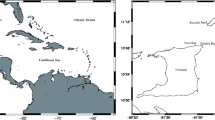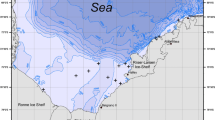Abstract
Photographic observations of the brittle starOphiura sarsi were conducted at a depth of approximately 280 m in the Pacific Ocean off Ōtsuchi, northeastern Japan. Bottom photographs showed that this ophiuroid occurred in high densities, uniformly covering the sea floor and that other megafauna was rare. The mean density and biomass of ophiuroids in the dense bed were estimated to be 373 m−2 and 124 g m−2, respectively. Ophiuroids comprised 99% of all megabenthic organisms in terms of number of individuals, and megafaunal assemblage of the dense bed showed very low species diversity.O. sarsi exhibited a regular spatial pattern avoiding contact with conspecific neighbors. This regular spatial pattern was disrupted by certain other organisms, around which halo-like, bare areas were observed. The size and shape of these halo-like areas varied and were apparently related to the body size and/or motility of the organisms. In the present observation areaO. sarsi covered 96% of the sea bottom, and the remaining 4% was occupied by other organisms and their halo-like bare areas.
Similar content being viewed by others
References
Aronson, R.B. and C.A. Harms (1985): Ophiuroids in a Bahamian saltwater lake: the ecology of a Paleozoic-like community. Ecology,66, 1472–1483.
Aronson, R.B. and H.-D. Sues (1987): The paleoecological significance of an anachronistic community. p. 355–366.In: Predation: Direct and Indirect Impacts on Aquatic Communities, ed. by W.C. Kerfoot and A. Sih, University Press of New England, Hanover.
Astrahantseff, S. and M.S. Alton (1965): Bathymetric distribution of brittle-stars (Ophiuroidea) collected off the northern Oregon coast. J. Fish. Res. Bd. Can.,22, 1407–1424.
Barham, E.G., N.J. Ayer, Jr. and R.E. Boyce (1967): Macrobenthos of the San Diego Trough: photographic census and observations from bathyscaphe,Trieste. Deep-Sea Res.,14, 773–784.
Blaber, S.J.M., J.L. May, J.W. Young and C.M. Bulman (1987): Population density and predators ofOphiacantha fidelis (Koehler, 1930) (Echinodermata: Ophiuroidea) on the continental slope of Tasmania. Austr. J. Mar. Freshwat. Res.,38, 243–247.
Brun, E. (1969): Aggregation ofOphiothrix fragilis (Abildgaard) (Echinodermata: Ophiuroidea). Nytt Mag. Zool.,17, 153–160.
Clark, P.J. and F.C. Evans (1954): Distance to nearest neighbour as a measure of spatial relationships in populations. Ecology,35, 445–453.
Conan, G., M. Roux and M. Sibuet (1981): A photographic survey of a population of the stalked crinoidDiplocrinus (Annacrinus) wyvillethomsoni (Echinodermata) from the bathyal slope of the Bay of Biscay. Deep-Sea Res.,28, 441–453.
Djakonov, A.M. (1954):Ophiuroids of the USSR Seas, the Zoological Institute of the Academy Science of the USSR, Moskow, 136 pp. (translated from Russian by Israel Program for Scientific translations, 1967, 123 pp.)
Fujita, T. (1989): Ecological study on the deep-sea echinoderms through photographic observations in the bathyal zone around Japan. Doctoral Dissertation, University of Tokyo, 134 pp.
Fujita, T. and S. Ohta (1988): Photographic observations of the life style of a deep-sea ophiuroidAsteronyx loveni (Echinodermata). Deep-sea Res.,35, 2029–2043.
Grassle, J.F., H.L. Sanders, R.R. Hessler, G.T. Rowe and T. McLellan (1975): Pattern and zonation: a study of the bathyal megafauna using the research submersibleAlvin. Deep-Sea Res,22, 457–481.
Haedrich, R.L., G.T. Rowe and P.T. Polloni (1980): The megabenthic fauna in the deep sea south of New England, USA. Mar. Biol.,57, 165–179.
Hashimoto, J. and H. Hotta (1985): An attempt of density estimation of megalo-epibenthos by the deep towed TV system and the deep sea research submersible “SHINKAI 2000”. JAMSTECTR Deepsea Res.,1985, 23–35 (in Japanese with English abstract).
Hutchinson, G.E. (1953): The concept of pattern in ecology. Proc. Acad. Nat. Sci. Phil.,105, 1–12.
Jumars, P.A. and J.E. Eckman (1983): Spatial structure within deep-sea benthic communities. p. 399–451.In: The Sea, vol. 8, Deep-Sea Biology, ed. by G. T. Rowe, Wiley-Interscience, New York.
Morisita, M. (1959): Measuring of the dispersion of individuals and analysis of the distributional patterns. Mem. Fac. Sci. Kyushu Univ. Ser. E (Biol.),2, 215–235.
Mortensen, T. (1927): Handbook of the Echinoderms of the British Isles. Oxford University Press, London, 471 pp.
Muus, K. (1981): Density and growth of juvenileAmphiura filiformis (Ophiuroidea) in the Oresund. Ophelia,20, 153–168.
Ohta, S. (1976): A precise and continuous monitoring system of the distance between the near-bottom instruments and the sea floor. J. Oceanogr. Soc. Japan,32, 65–73.
Ohta, S. (1983): Photographic census of large-sized benthic organisms in the bathyal zone of Suruga Bay, central Japan. Bull. Ocean Res. Inst. Univ. Tokyo,15, 1–244.
Pielou, E.C. (1977): Mathematical Ecology, 2nd ed., Wiley Interscience, New York, 385 pp.
Reese, E.S. (1966): The complex behavior of echinoderms. p. 157–218.In: Physiology of Echinodermata, ed. by R.A. Boolootian, Wiley-Interscience, New York.
Rex, M.A. (1983): Geographic patterns of species diversity in the deep-sea benthos. p. 453–472.In: The Sea, vol. 8, Deep-Sea Biology, ed. by G.T. Rowe, Wiley-Interscience, New York.
Rowe, G.T. and R.J. Menzies (1969): Zonation of large benthic invertebrates in the deep sea off the Carolinas. Deep-Sea Res.,16, 531–537.
Smith, C.R. (1985): Food for the deep sea: utilization, dispersal, and flux of nekton falls at the Santa Catalina Basin floor. Deep-Sea Res.,32, 417–442.
Smith, C.R. and S.C. Hamilton (1983): Epibenthic megafauna of a bathyal basin off southern California: patterns of abundance, biomass, and dispersion. Deep-Sea Res.,30, 907–928.
Smith, K.L., Jr. and N.O. Brown (1983): Oxygen consumption of pelagic juveniles and demersal adults of the deep-sea fishSebastolobus altivelis, measured at depth. Mar. Biol.,76, 325–332.
Vevers, H.G. (1951): Photography of the sea floor. J. Mar. Biol. Ass. U. K.,30, 101–111.
Vevers, H.G. (1952): A photographic survey of certain areas of sea floor near Plymouth. J. Mar. Biol. Ass. U. K.,31, 215–221.
Warner, G.F. (1971): On the ecology of a dense bed of the brittle-starOphiothrix fragilis. J. Mar. Biol. Ass. U. K.,51, 267–282.
Warner, G.F. (1982): Food and feeding mechanisms: Ophiruoidea. p. 161–181.In: Echinoderm Nutrition, ed. by M. Jangoux and J. M. Lawrence, Balkema, Rotterdam.
Wigley, R.L. and K.O. Emery (1967): Benthic animals, particularlyHyalinoecia (Annelida) andOphiomusium (Echinodermata) in sea-bottom photographs from the continental slope. p. 235–249.In: Deep-Sea Photography, ed. by J. B. Hersey, John Hopkins Press, Baltimore.
Wilson, J.B., N.A. Holme and R.L. Barrett (1977): Population dispersal in the brittle-starOphiocomina nigra (Abildgaard) (Echinodermata: Ophiuroldea). J. Mar. Biol. Ass. U. K.,57, 405–439.
Author information
Authors and Affiliations
Rights and permissions
About this article
Cite this article
Fujita, T., Ohta, S. Spatial structure within a dense bed of the brittle starOphiura sarsi (Ophiuroidea: Echinodermata) in the bathyal zone off otsuchi, Northeastern Japan. Journal of the Oceanographical Society of Japan 45, 289–300 (1989). https://doi.org/10.1007/BF02123483
Received:
Revised:
Accepted:
Published:
Issue Date:
DOI: https://doi.org/10.1007/BF02123483




